Role of Nurses in Delivering Primary Care for Cystic Fibrosis Patients
VerifiedAdded on 2023/03/30
|10
|2116
|183
Report
AI Summary
This report delves into the principles of primary care for patients with cystic fibrosis, emphasizing the crucial role of nurses in health promotion. It examines the application of the Ottawa Charter for Health Promotion, highlighting five key action areas: building healthy public policy, creating supportive environments, strengthening community actions, developing personal skills, and reorienting health services. The report details how nurses can implement these principles through strategies like advocacy, enablement, and mediation to improve patient outcomes. It also underscores the importance of nurses' continuous professional development, patient education, and collaboration with various organizations to provide holistic and sustainable care. The conclusion stresses the need for a comprehensive approach that addresses both the physiological and socio-economic needs of cystic fibrosis patients to ensure optimal health and well-being.

Running head: PRINCIPLES OF PRIMARY CARE: CYSTIC FIBROSIS
PRINCIPLES OF PRIMARY CARE: CYSTIC FIBROSIS
Name of the Student:
Name of the University:
Author note:
PRINCIPLES OF PRIMARY CARE: CYSTIC FIBROSIS
Name of the Student:
Name of the University:
Author note:
Paraphrase This Document
Need a fresh take? Get an instant paraphrase of this document with our AI Paraphraser
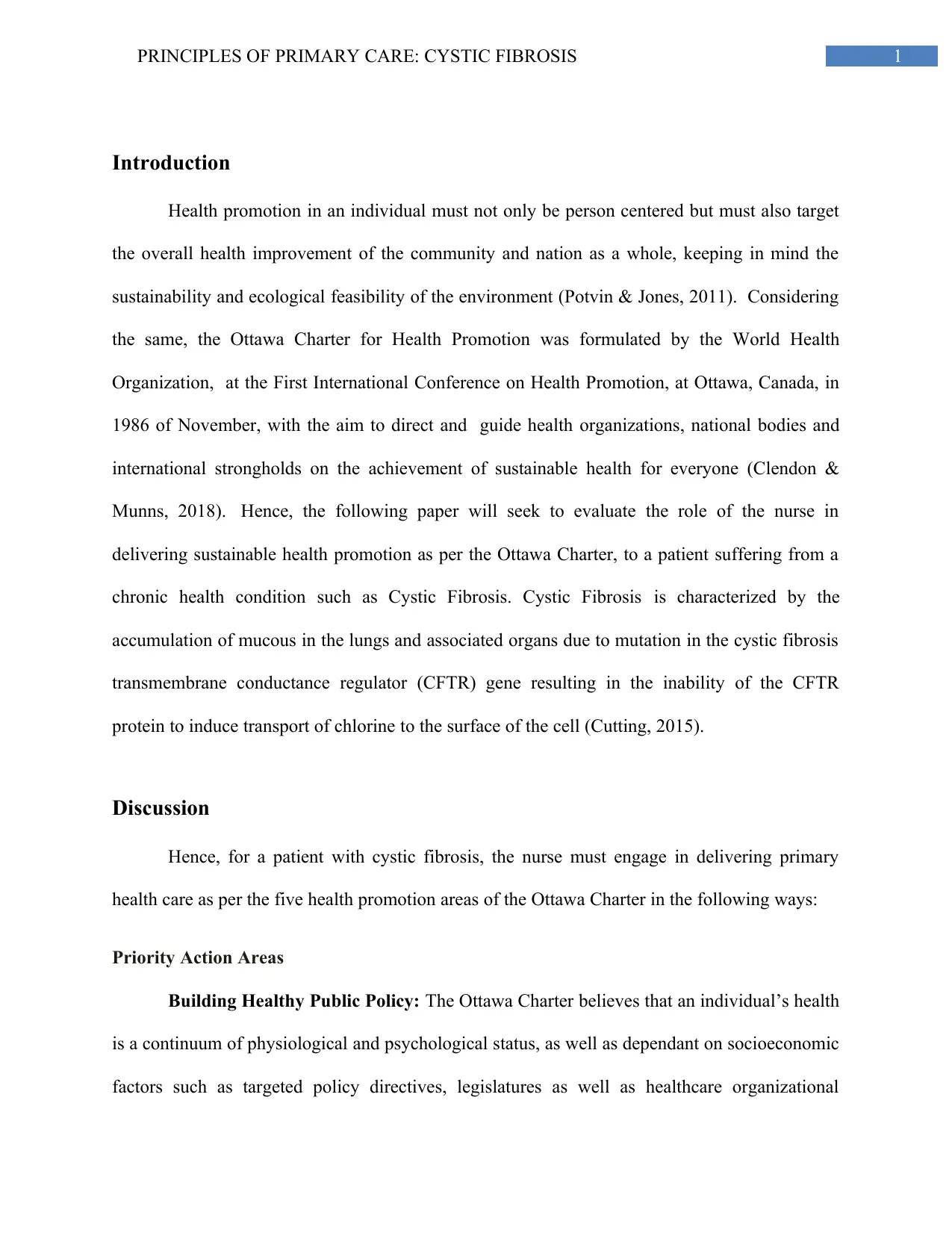
1PRINCIPLES OF PRIMARY CARE: CYSTIC FIBROSIS
Introduction
Health promotion in an individual must not only be person centered but must also target
the overall health improvement of the community and nation as a whole, keeping in mind the
sustainability and ecological feasibility of the environment (Potvin & Jones, 2011). Considering
the same, the Ottawa Charter for Health Promotion was formulated by the World Health
Organization, at the First International Conference on Health Promotion, at Ottawa, Canada, in
1986 of November, with the aim to direct and guide health organizations, national bodies and
international strongholds on the achievement of sustainable health for everyone (Clendon &
Munns, 2018). Hence, the following paper will seek to evaluate the role of the nurse in
delivering sustainable health promotion as per the Ottawa Charter, to a patient suffering from a
chronic health condition such as Cystic Fibrosis. Cystic Fibrosis is characterized by the
accumulation of mucous in the lungs and associated organs due to mutation in the cystic fibrosis
transmembrane conductance regulator (CFTR) gene resulting in the inability of the CFTR
protein to induce transport of chlorine to the surface of the cell (Cutting, 2015).
Discussion
Hence, for a patient with cystic fibrosis, the nurse must engage in delivering primary
health care as per the five health promotion areas of the Ottawa Charter in the following ways:
Priority Action Areas
Building Healthy Public Policy: The Ottawa Charter believes that an individual’s health
is a continuum of physiological and psychological status, as well as dependant on socioeconomic
factors such as targeted policy directives, legislatures as well as healthcare organizational
Introduction
Health promotion in an individual must not only be person centered but must also target
the overall health improvement of the community and nation as a whole, keeping in mind the
sustainability and ecological feasibility of the environment (Potvin & Jones, 2011). Considering
the same, the Ottawa Charter for Health Promotion was formulated by the World Health
Organization, at the First International Conference on Health Promotion, at Ottawa, Canada, in
1986 of November, with the aim to direct and guide health organizations, national bodies and
international strongholds on the achievement of sustainable health for everyone (Clendon &
Munns, 2018). Hence, the following paper will seek to evaluate the role of the nurse in
delivering sustainable health promotion as per the Ottawa Charter, to a patient suffering from a
chronic health condition such as Cystic Fibrosis. Cystic Fibrosis is characterized by the
accumulation of mucous in the lungs and associated organs due to mutation in the cystic fibrosis
transmembrane conductance regulator (CFTR) gene resulting in the inability of the CFTR
protein to induce transport of chlorine to the surface of the cell (Cutting, 2015).
Discussion
Hence, for a patient with cystic fibrosis, the nurse must engage in delivering primary
health care as per the five health promotion areas of the Ottawa Charter in the following ways:
Priority Action Areas
Building Healthy Public Policy: The Ottawa Charter believes that an individual’s health
is a continuum of physiological and psychological status, as well as dependant on socioeconomic
factors such as targeted policy directives, legislatures as well as healthcare organizational
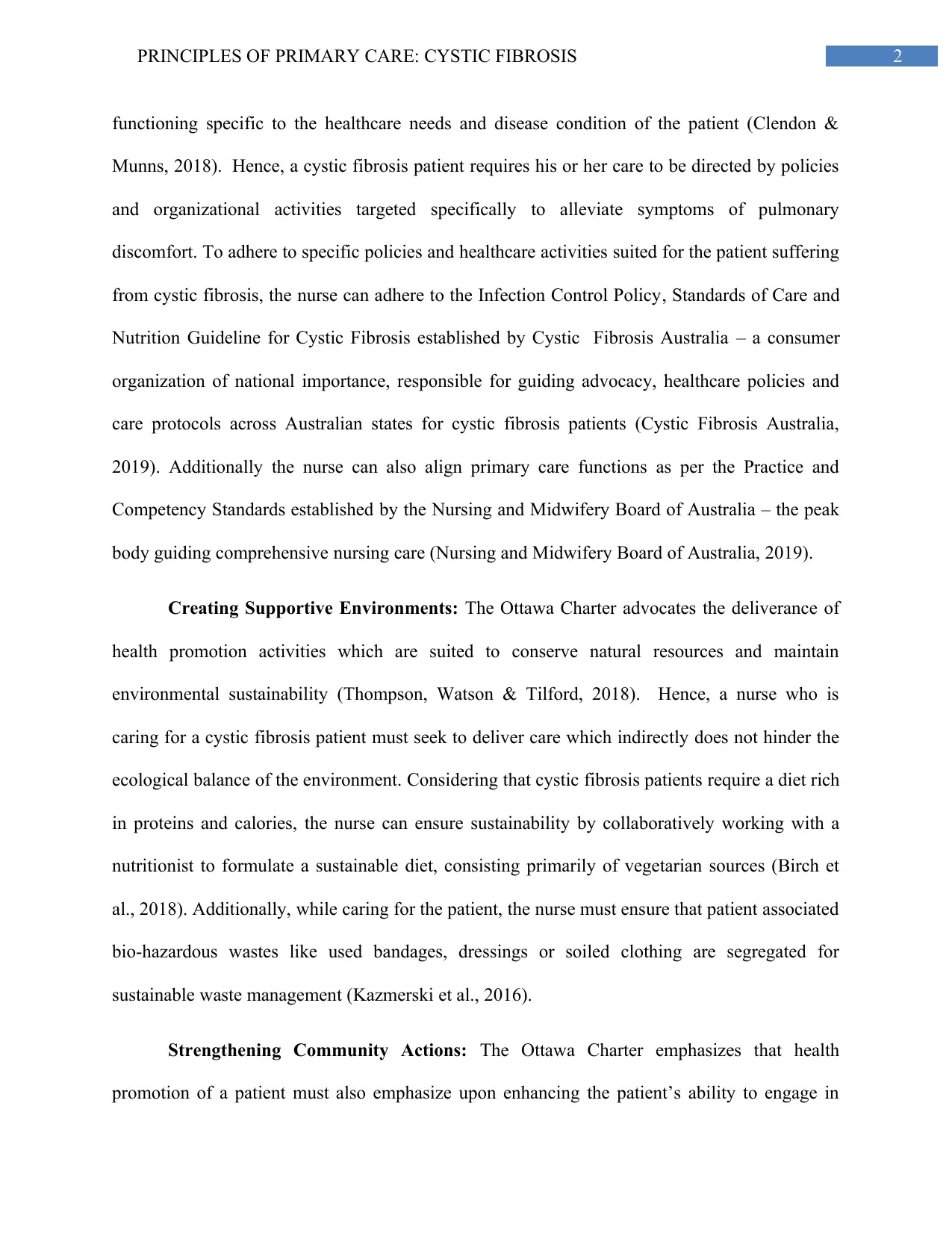
2PRINCIPLES OF PRIMARY CARE: CYSTIC FIBROSIS
functioning specific to the healthcare needs and disease condition of the patient (Clendon &
Munns, 2018). Hence, a cystic fibrosis patient requires his or her care to be directed by policies
and organizational activities targeted specifically to alleviate symptoms of pulmonary
discomfort. To adhere to specific policies and healthcare activities suited for the patient suffering
from cystic fibrosis, the nurse can adhere to the Infection Control Policy, Standards of Care and
Nutrition Guideline for Cystic Fibrosis established by Cystic Fibrosis Australia – a consumer
organization of national importance, responsible for guiding advocacy, healthcare policies and
care protocols across Australian states for cystic fibrosis patients (Cystic Fibrosis Australia,
2019). Additionally the nurse can also align primary care functions as per the Practice and
Competency Standards established by the Nursing and Midwifery Board of Australia – the peak
body guiding comprehensive nursing care (Nursing and Midwifery Board of Australia, 2019).
Creating Supportive Environments: The Ottawa Charter advocates the deliverance of
health promotion activities which are suited to conserve natural resources and maintain
environmental sustainability (Thompson, Watson & Tilford, 2018). Hence, a nurse who is
caring for a cystic fibrosis patient must seek to deliver care which indirectly does not hinder the
ecological balance of the environment. Considering that cystic fibrosis patients require a diet rich
in proteins and calories, the nurse can ensure sustainability by collaboratively working with a
nutritionist to formulate a sustainable diet, consisting primarily of vegetarian sources (Birch et
al., 2018). Additionally, while caring for the patient, the nurse must ensure that patient associated
bio-hazardous wastes like used bandages, dressings or soiled clothing are segregated for
sustainable waste management (Kazmerski et al., 2016).
Strengthening Community Actions: The Ottawa Charter emphasizes that health
promotion of a patient must also emphasize upon enhancing the patient’s ability to engage in
functioning specific to the healthcare needs and disease condition of the patient (Clendon &
Munns, 2018). Hence, a cystic fibrosis patient requires his or her care to be directed by policies
and organizational activities targeted specifically to alleviate symptoms of pulmonary
discomfort. To adhere to specific policies and healthcare activities suited for the patient suffering
from cystic fibrosis, the nurse can adhere to the Infection Control Policy, Standards of Care and
Nutrition Guideline for Cystic Fibrosis established by Cystic Fibrosis Australia – a consumer
organization of national importance, responsible for guiding advocacy, healthcare policies and
care protocols across Australian states for cystic fibrosis patients (Cystic Fibrosis Australia,
2019). Additionally the nurse can also align primary care functions as per the Practice and
Competency Standards established by the Nursing and Midwifery Board of Australia – the peak
body guiding comprehensive nursing care (Nursing and Midwifery Board of Australia, 2019).
Creating Supportive Environments: The Ottawa Charter advocates the deliverance of
health promotion activities which are suited to conserve natural resources and maintain
environmental sustainability (Thompson, Watson & Tilford, 2018). Hence, a nurse who is
caring for a cystic fibrosis patient must seek to deliver care which indirectly does not hinder the
ecological balance of the environment. Considering that cystic fibrosis patients require a diet rich
in proteins and calories, the nurse can ensure sustainability by collaboratively working with a
nutritionist to formulate a sustainable diet, consisting primarily of vegetarian sources (Birch et
al., 2018). Additionally, while caring for the patient, the nurse must ensure that patient associated
bio-hazardous wastes like used bandages, dressings or soiled clothing are segregated for
sustainable waste management (Kazmerski et al., 2016).
Strengthening Community Actions: The Ottawa Charter emphasizes that health
promotion of a patient must also emphasize upon enhancing the patient’s ability to engage in
⊘ This is a preview!⊘
Do you want full access?
Subscribe today to unlock all pages.

Trusted by 1+ million students worldwide
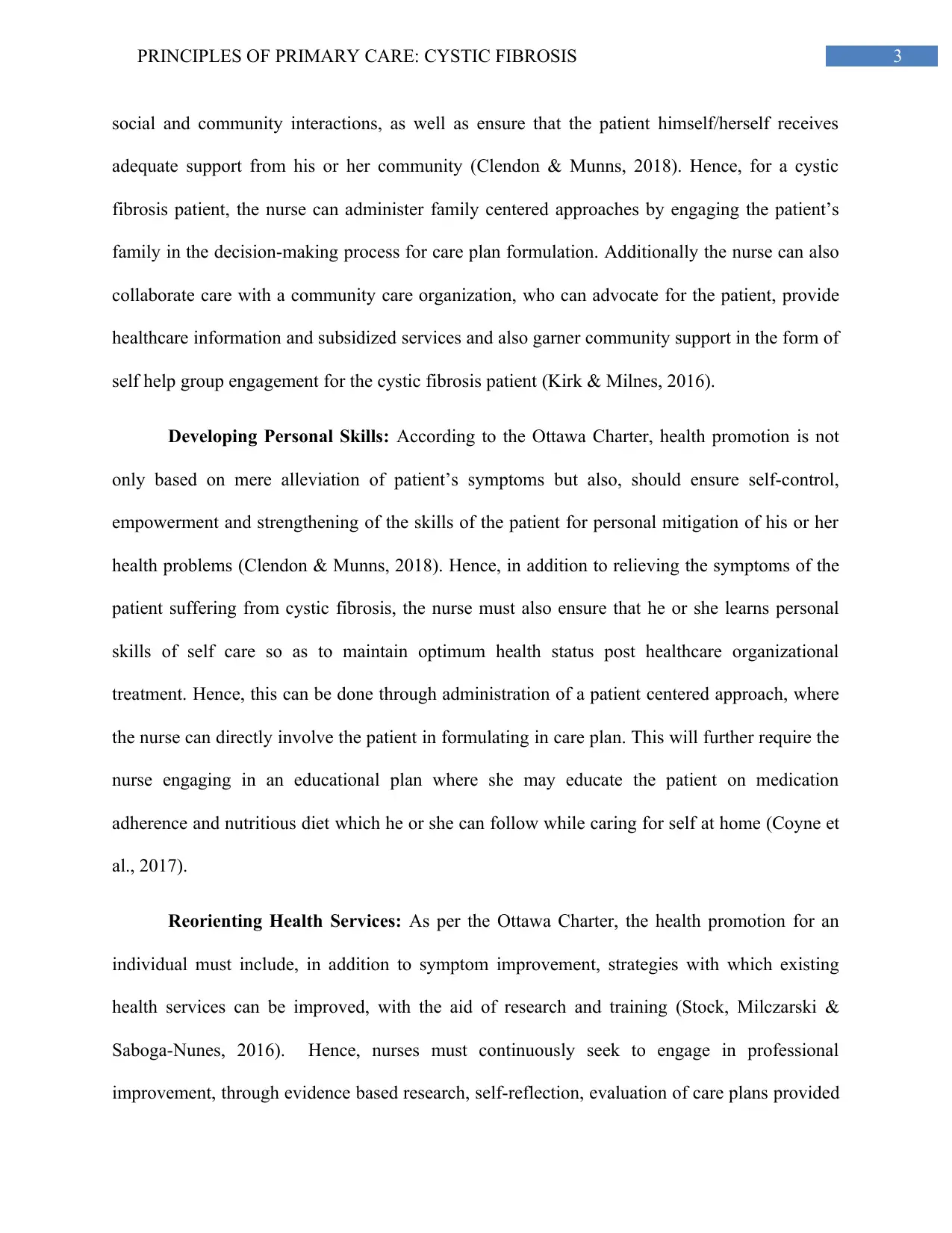
3PRINCIPLES OF PRIMARY CARE: CYSTIC FIBROSIS
social and community interactions, as well as ensure that the patient himself/herself receives
adequate support from his or her community (Clendon & Munns, 2018). Hence, for a cystic
fibrosis patient, the nurse can administer family centered approaches by engaging the patient’s
family in the decision-making process for care plan formulation. Additionally the nurse can also
collaborate care with a community care organization, who can advocate for the patient, provide
healthcare information and subsidized services and also garner community support in the form of
self help group engagement for the cystic fibrosis patient (Kirk & Milnes, 2016).
Developing Personal Skills: According to the Ottawa Charter, health promotion is not
only based on mere alleviation of patient’s symptoms but also, should ensure self-control,
empowerment and strengthening of the skills of the patient for personal mitigation of his or her
health problems (Clendon & Munns, 2018). Hence, in addition to relieving the symptoms of the
patient suffering from cystic fibrosis, the nurse must also ensure that he or she learns personal
skills of self care so as to maintain optimum health status post healthcare organizational
treatment. Hence, this can be done through administration of a patient centered approach, where
the nurse can directly involve the patient in formulating in care plan. This will further require the
nurse engaging in an educational plan where she may educate the patient on medication
adherence and nutritious diet which he or she can follow while caring for self at home (Coyne et
al., 2017).
Reorienting Health Services: As per the Ottawa Charter, the health promotion for an
individual must include, in addition to symptom improvement, strategies with which existing
health services can be improved, with the aid of research and training (Stock, Milczarski &
Saboga-Nunes, 2016). Hence, nurses must continuously seek to engage in professional
improvement, through evidence based research, self-reflection, evaluation of care plans provided
social and community interactions, as well as ensure that the patient himself/herself receives
adequate support from his or her community (Clendon & Munns, 2018). Hence, for a cystic
fibrosis patient, the nurse can administer family centered approaches by engaging the patient’s
family in the decision-making process for care plan formulation. Additionally the nurse can also
collaborate care with a community care organization, who can advocate for the patient, provide
healthcare information and subsidized services and also garner community support in the form of
self help group engagement for the cystic fibrosis patient (Kirk & Milnes, 2016).
Developing Personal Skills: According to the Ottawa Charter, health promotion is not
only based on mere alleviation of patient’s symptoms but also, should ensure self-control,
empowerment and strengthening of the skills of the patient for personal mitigation of his or her
health problems (Clendon & Munns, 2018). Hence, in addition to relieving the symptoms of the
patient suffering from cystic fibrosis, the nurse must also ensure that he or she learns personal
skills of self care so as to maintain optimum health status post healthcare organizational
treatment. Hence, this can be done through administration of a patient centered approach, where
the nurse can directly involve the patient in formulating in care plan. This will further require the
nurse engaging in an educational plan where she may educate the patient on medication
adherence and nutritious diet which he or she can follow while caring for self at home (Coyne et
al., 2017).
Reorienting Health Services: As per the Ottawa Charter, the health promotion for an
individual must include, in addition to symptom improvement, strategies with which existing
health services can be improved, with the aid of research and training (Stock, Milczarski &
Saboga-Nunes, 2016). Hence, nurses must continuously seek to engage in professional
improvement, through evidence based research, self-reflection, evaluation of care plans provided
Paraphrase This Document
Need a fresh take? Get an instant paraphrase of this document with our AI Paraphraser
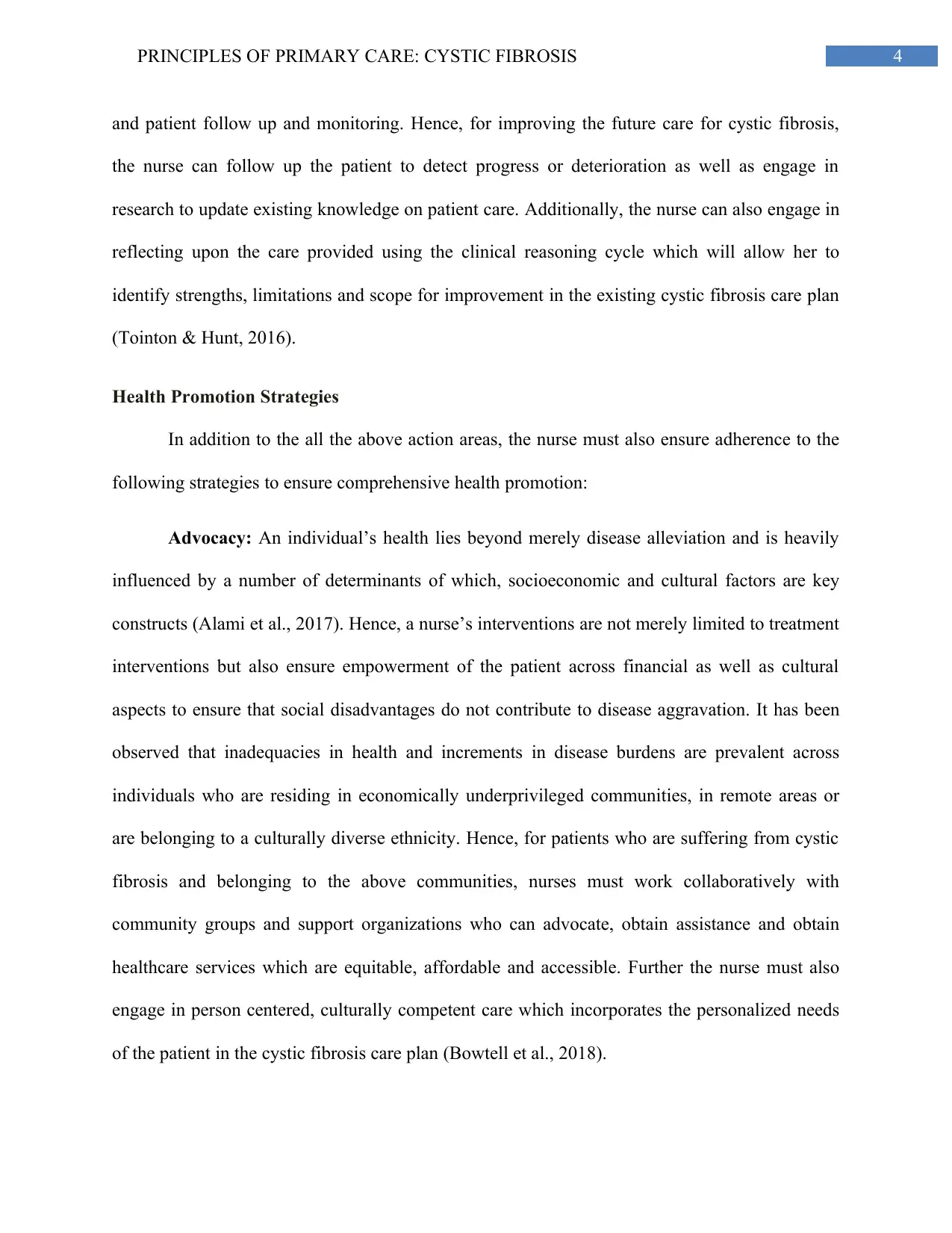
4PRINCIPLES OF PRIMARY CARE: CYSTIC FIBROSIS
and patient follow up and monitoring. Hence, for improving the future care for cystic fibrosis,
the nurse can follow up the patient to detect progress or deterioration as well as engage in
research to update existing knowledge on patient care. Additionally, the nurse can also engage in
reflecting upon the care provided using the clinical reasoning cycle which will allow her to
identify strengths, limitations and scope for improvement in the existing cystic fibrosis care plan
(Tointon & Hunt, 2016).
Health Promotion Strategies
In addition to the all the above action areas, the nurse must also ensure adherence to the
following strategies to ensure comprehensive health promotion:
Advocacy: An individual’s health lies beyond merely disease alleviation and is heavily
influenced by a number of determinants of which, socioeconomic and cultural factors are key
constructs (Alami et al., 2017). Hence, a nurse’s interventions are not merely limited to treatment
interventions but also ensure empowerment of the patient across financial as well as cultural
aspects to ensure that social disadvantages do not contribute to disease aggravation. It has been
observed that inadequacies in health and increments in disease burdens are prevalent across
individuals who are residing in economically underprivileged communities, in remote areas or
are belonging to a culturally diverse ethnicity. Hence, for patients who are suffering from cystic
fibrosis and belonging to the above communities, nurses must work collaboratively with
community groups and support organizations who can advocate, obtain assistance and obtain
healthcare services which are equitable, affordable and accessible. Further the nurse must also
engage in person centered, culturally competent care which incorporates the personalized needs
of the patient in the cystic fibrosis care plan (Bowtell et al., 2018).
and patient follow up and monitoring. Hence, for improving the future care for cystic fibrosis,
the nurse can follow up the patient to detect progress or deterioration as well as engage in
research to update existing knowledge on patient care. Additionally, the nurse can also engage in
reflecting upon the care provided using the clinical reasoning cycle which will allow her to
identify strengths, limitations and scope for improvement in the existing cystic fibrosis care plan
(Tointon & Hunt, 2016).
Health Promotion Strategies
In addition to the all the above action areas, the nurse must also ensure adherence to the
following strategies to ensure comprehensive health promotion:
Advocacy: An individual’s health lies beyond merely disease alleviation and is heavily
influenced by a number of determinants of which, socioeconomic and cultural factors are key
constructs (Alami et al., 2017). Hence, a nurse’s interventions are not merely limited to treatment
interventions but also ensure empowerment of the patient across financial as well as cultural
aspects to ensure that social disadvantages do not contribute to disease aggravation. It has been
observed that inadequacies in health and increments in disease burdens are prevalent across
individuals who are residing in economically underprivileged communities, in remote areas or
are belonging to a culturally diverse ethnicity. Hence, for patients who are suffering from cystic
fibrosis and belonging to the above communities, nurses must work collaboratively with
community groups and support organizations who can advocate, obtain assistance and obtain
healthcare services which are equitable, affordable and accessible. Further the nurse must also
engage in person centered, culturally competent care which incorporates the personalized needs
of the patient in the cystic fibrosis care plan (Bowtell et al., 2018).
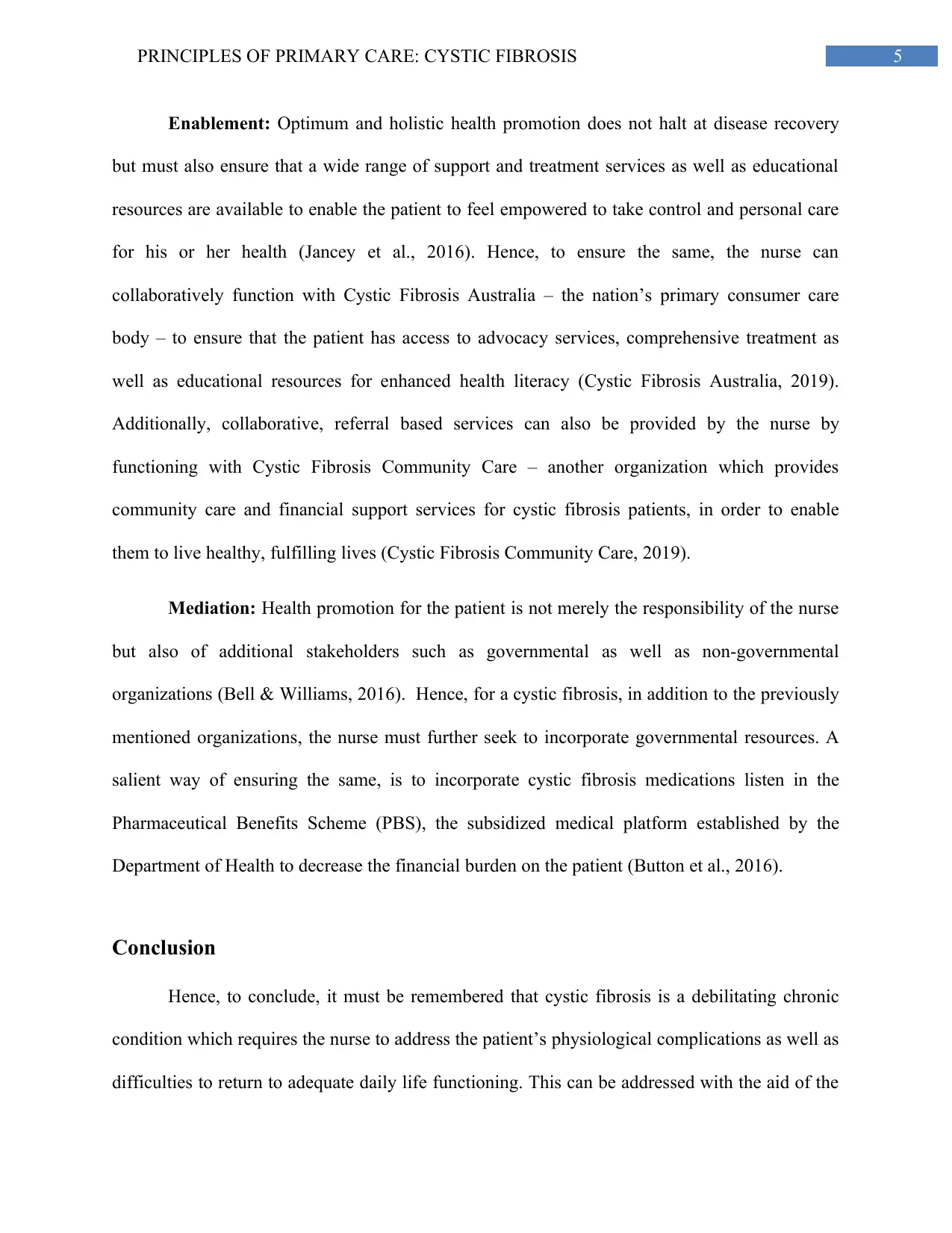
5PRINCIPLES OF PRIMARY CARE: CYSTIC FIBROSIS
Enablement: Optimum and holistic health promotion does not halt at disease recovery
but must also ensure that a wide range of support and treatment services as well as educational
resources are available to enable the patient to feel empowered to take control and personal care
for his or her health (Jancey et al., 2016). Hence, to ensure the same, the nurse can
collaboratively function with Cystic Fibrosis Australia – the nation’s primary consumer care
body – to ensure that the patient has access to advocacy services, comprehensive treatment as
well as educational resources for enhanced health literacy (Cystic Fibrosis Australia, 2019).
Additionally, collaborative, referral based services can also be provided by the nurse by
functioning with Cystic Fibrosis Community Care – another organization which provides
community care and financial support services for cystic fibrosis patients, in order to enable
them to live healthy, fulfilling lives (Cystic Fibrosis Community Care, 2019).
Mediation: Health promotion for the patient is not merely the responsibility of the nurse
but also of additional stakeholders such as governmental as well as non-governmental
organizations (Bell & Williams, 2016). Hence, for a cystic fibrosis, in addition to the previously
mentioned organizations, the nurse must further seek to incorporate governmental resources. A
salient way of ensuring the same, is to incorporate cystic fibrosis medications listen in the
Pharmaceutical Benefits Scheme (PBS), the subsidized medical platform established by the
Department of Health to decrease the financial burden on the patient (Button et al., 2016).
Conclusion
Hence, to conclude, it must be remembered that cystic fibrosis is a debilitating chronic
condition which requires the nurse to address the patient’s physiological complications as well as
difficulties to return to adequate daily life functioning. This can be addressed with the aid of the
Enablement: Optimum and holistic health promotion does not halt at disease recovery
but must also ensure that a wide range of support and treatment services as well as educational
resources are available to enable the patient to feel empowered to take control and personal care
for his or her health (Jancey et al., 2016). Hence, to ensure the same, the nurse can
collaboratively function with Cystic Fibrosis Australia – the nation’s primary consumer care
body – to ensure that the patient has access to advocacy services, comprehensive treatment as
well as educational resources for enhanced health literacy (Cystic Fibrosis Australia, 2019).
Additionally, collaborative, referral based services can also be provided by the nurse by
functioning with Cystic Fibrosis Community Care – another organization which provides
community care and financial support services for cystic fibrosis patients, in order to enable
them to live healthy, fulfilling lives (Cystic Fibrosis Community Care, 2019).
Mediation: Health promotion for the patient is not merely the responsibility of the nurse
but also of additional stakeholders such as governmental as well as non-governmental
organizations (Bell & Williams, 2016). Hence, for a cystic fibrosis, in addition to the previously
mentioned organizations, the nurse must further seek to incorporate governmental resources. A
salient way of ensuring the same, is to incorporate cystic fibrosis medications listen in the
Pharmaceutical Benefits Scheme (PBS), the subsidized medical platform established by the
Department of Health to decrease the financial burden on the patient (Button et al., 2016).
Conclusion
Hence, to conclude, it must be remembered that cystic fibrosis is a debilitating chronic
condition which requires the nurse to address the patient’s physiological complications as well as
difficulties to return to adequate daily life functioning. This can be addressed with the aid of the
⊘ This is a preview!⊘
Do you want full access?
Subscribe today to unlock all pages.

Trusted by 1+ million students worldwide
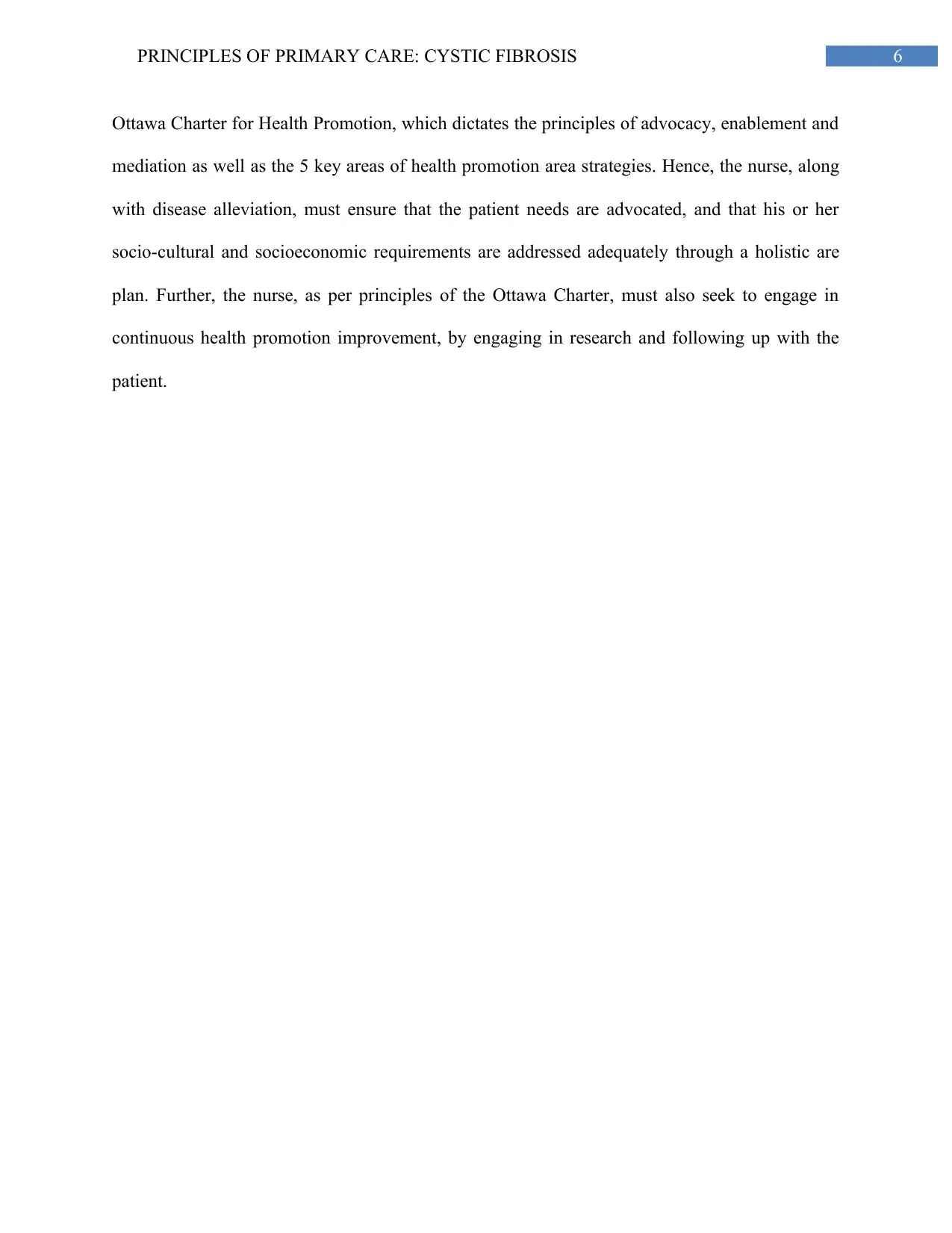
6PRINCIPLES OF PRIMARY CARE: CYSTIC FIBROSIS
Ottawa Charter for Health Promotion, which dictates the principles of advocacy, enablement and
mediation as well as the 5 key areas of health promotion area strategies. Hence, the nurse, along
with disease alleviation, must ensure that the patient needs are advocated, and that his or her
socio-cultural and socioeconomic requirements are addressed adequately through a holistic are
plan. Further, the nurse, as per principles of the Ottawa Charter, must also seek to engage in
continuous health promotion improvement, by engaging in research and following up with the
patient.
Ottawa Charter for Health Promotion, which dictates the principles of advocacy, enablement and
mediation as well as the 5 key areas of health promotion area strategies. Hence, the nurse, along
with disease alleviation, must ensure that the patient needs are advocated, and that his or her
socio-cultural and socioeconomic requirements are addressed adequately through a holistic are
plan. Further, the nurse, as per principles of the Ottawa Charter, must also seek to engage in
continuous health promotion improvement, by engaging in research and following up with the
patient.
Paraphrase This Document
Need a fresh take? Get an instant paraphrase of this document with our AI Paraphraser
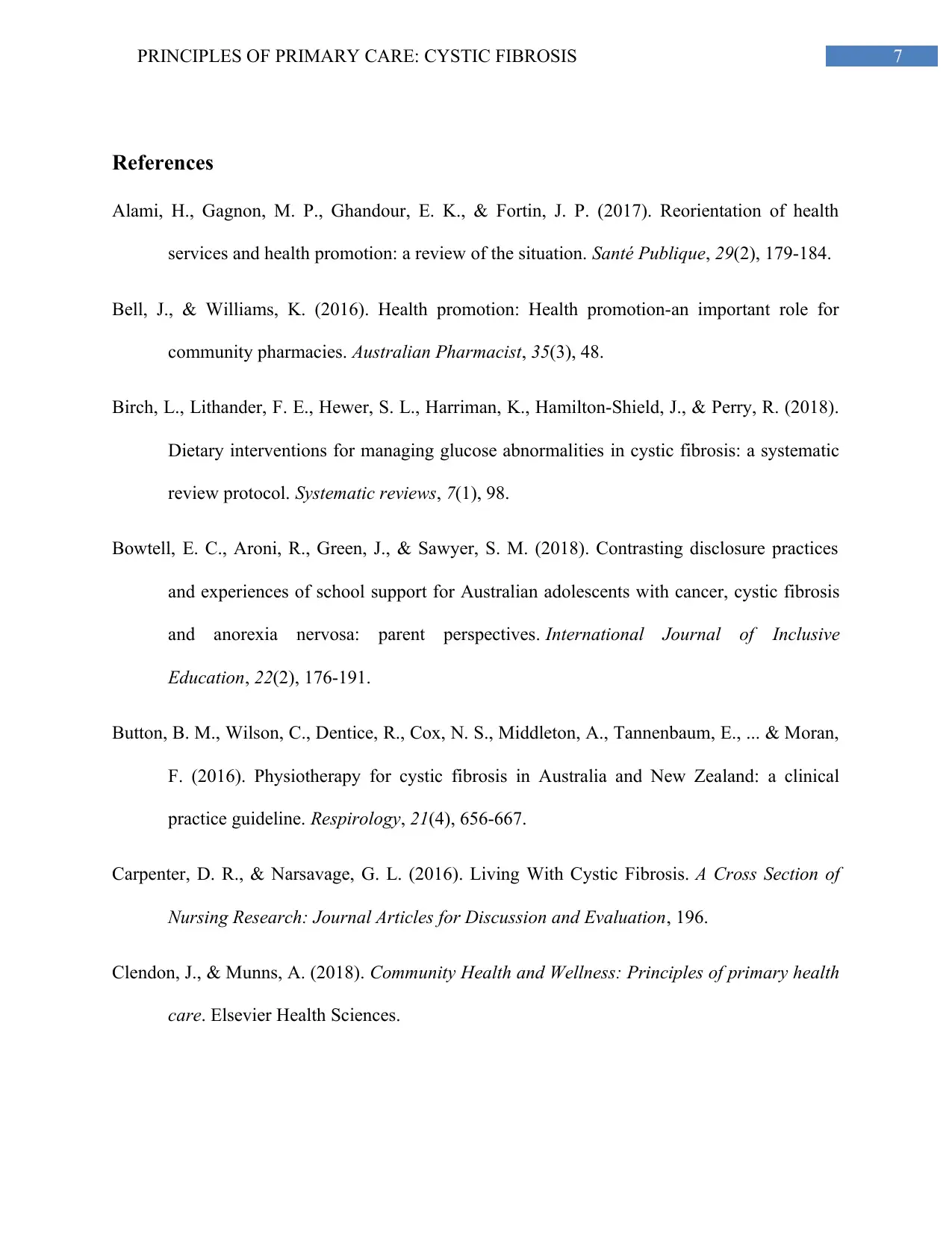
7PRINCIPLES OF PRIMARY CARE: CYSTIC FIBROSIS
References
Alami, H., Gagnon, M. P., Ghandour, E. K., & Fortin, J. P. (2017). Reorientation of health
services and health promotion: a review of the situation. Santé Publique, 29(2), 179-184.
Bell, J., & Williams, K. (2016). Health promotion: Health promotion-an important role for
community pharmacies. Australian Pharmacist, 35(3), 48.
Birch, L., Lithander, F. E., Hewer, S. L., Harriman, K., Hamilton-Shield, J., & Perry, R. (2018).
Dietary interventions for managing glucose abnormalities in cystic fibrosis: a systematic
review protocol. Systematic reviews, 7(1), 98.
Bowtell, E. C., Aroni, R., Green, J., & Sawyer, S. M. (2018). Contrasting disclosure practices
and experiences of school support for Australian adolescents with cancer, cystic fibrosis
and anorexia nervosa: parent perspectives. International Journal of Inclusive
Education, 22(2), 176-191.
Button, B. M., Wilson, C., Dentice, R., Cox, N. S., Middleton, A., Tannenbaum, E., ... & Moran,
F. (2016). Physiotherapy for cystic fibrosis in Australia and New Zealand: a clinical
practice guideline. Respirology, 21(4), 656-667.
Carpenter, D. R., & Narsavage, G. L. (2016). Living With Cystic Fibrosis. A Cross Section of
Nursing Research: Journal Articles for Discussion and Evaluation, 196.
Clendon, J., & Munns, A. (2018). Community Health and Wellness: Principles of primary health
care. Elsevier Health Sciences.
References
Alami, H., Gagnon, M. P., Ghandour, E. K., & Fortin, J. P. (2017). Reorientation of health
services and health promotion: a review of the situation. Santé Publique, 29(2), 179-184.
Bell, J., & Williams, K. (2016). Health promotion: Health promotion-an important role for
community pharmacies. Australian Pharmacist, 35(3), 48.
Birch, L., Lithander, F. E., Hewer, S. L., Harriman, K., Hamilton-Shield, J., & Perry, R. (2018).
Dietary interventions for managing glucose abnormalities in cystic fibrosis: a systematic
review protocol. Systematic reviews, 7(1), 98.
Bowtell, E. C., Aroni, R., Green, J., & Sawyer, S. M. (2018). Contrasting disclosure practices
and experiences of school support for Australian adolescents with cancer, cystic fibrosis
and anorexia nervosa: parent perspectives. International Journal of Inclusive
Education, 22(2), 176-191.
Button, B. M., Wilson, C., Dentice, R., Cox, N. S., Middleton, A., Tannenbaum, E., ... & Moran,
F. (2016). Physiotherapy for cystic fibrosis in Australia and New Zealand: a clinical
practice guideline. Respirology, 21(4), 656-667.
Carpenter, D. R., & Narsavage, G. L. (2016). Living With Cystic Fibrosis. A Cross Section of
Nursing Research: Journal Articles for Discussion and Evaluation, 196.
Clendon, J., & Munns, A. (2018). Community Health and Wellness: Principles of primary health
care. Elsevier Health Sciences.
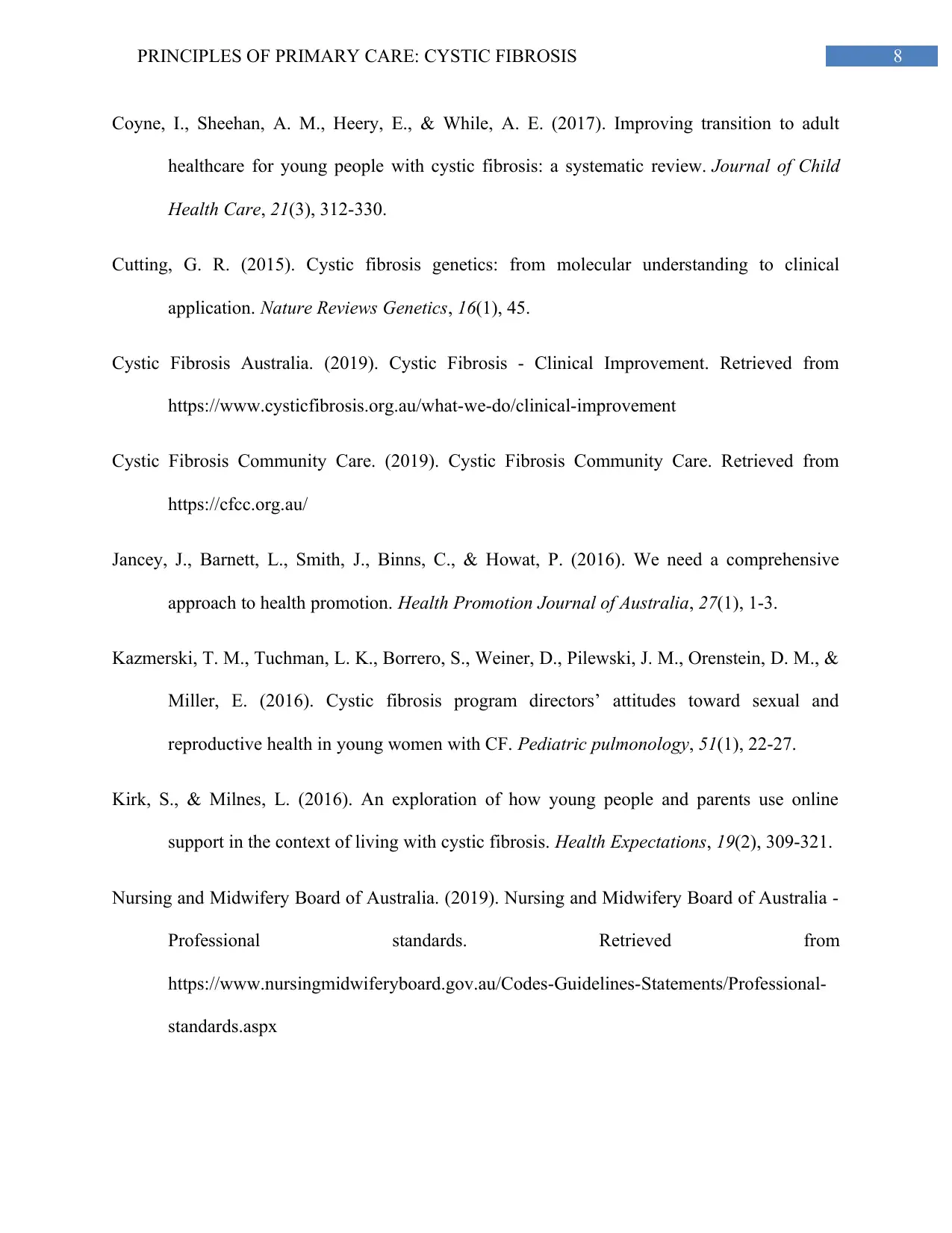
8PRINCIPLES OF PRIMARY CARE: CYSTIC FIBROSIS
Coyne, I., Sheehan, A. M., Heery, E., & While, A. E. (2017). Improving transition to adult
healthcare for young people with cystic fibrosis: a systematic review. Journal of Child
Health Care, 21(3), 312-330.
Cutting, G. R. (2015). Cystic fibrosis genetics: from molecular understanding to clinical
application. Nature Reviews Genetics, 16(1), 45.
Cystic Fibrosis Australia. (2019). Cystic Fibrosis - Clinical Improvement. Retrieved from
https://www.cysticfibrosis.org.au/what-we-do/clinical-improvement
Cystic Fibrosis Community Care. (2019). Cystic Fibrosis Community Care. Retrieved from
https://cfcc.org.au/
Jancey, J., Barnett, L., Smith, J., Binns, C., & Howat, P. (2016). We need a comprehensive
approach to health promotion. Health Promotion Journal of Australia, 27(1), 1-3.
Kazmerski, T. M., Tuchman, L. K., Borrero, S., Weiner, D., Pilewski, J. M., Orenstein, D. M., &
Miller, E. (2016). Cystic fibrosis program directors’ attitudes toward sexual and
reproductive health in young women with CF. Pediatric pulmonology, 51(1), 22-27.
Kirk, S., & Milnes, L. (2016). An exploration of how young people and parents use online
support in the context of living with cystic fibrosis. Health Expectations, 19(2), 309-321.
Nursing and Midwifery Board of Australia. (2019). Nursing and Midwifery Board of Australia -
Professional standards. Retrieved from
https://www.nursingmidwiferyboard.gov.au/Codes-Guidelines-Statements/Professional-
standards.aspx
Coyne, I., Sheehan, A. M., Heery, E., & While, A. E. (2017). Improving transition to adult
healthcare for young people with cystic fibrosis: a systematic review. Journal of Child
Health Care, 21(3), 312-330.
Cutting, G. R. (2015). Cystic fibrosis genetics: from molecular understanding to clinical
application. Nature Reviews Genetics, 16(1), 45.
Cystic Fibrosis Australia. (2019). Cystic Fibrosis - Clinical Improvement. Retrieved from
https://www.cysticfibrosis.org.au/what-we-do/clinical-improvement
Cystic Fibrosis Community Care. (2019). Cystic Fibrosis Community Care. Retrieved from
https://cfcc.org.au/
Jancey, J., Barnett, L., Smith, J., Binns, C., & Howat, P. (2016). We need a comprehensive
approach to health promotion. Health Promotion Journal of Australia, 27(1), 1-3.
Kazmerski, T. M., Tuchman, L. K., Borrero, S., Weiner, D., Pilewski, J. M., Orenstein, D. M., &
Miller, E. (2016). Cystic fibrosis program directors’ attitudes toward sexual and
reproductive health in young women with CF. Pediatric pulmonology, 51(1), 22-27.
Kirk, S., & Milnes, L. (2016). An exploration of how young people and parents use online
support in the context of living with cystic fibrosis. Health Expectations, 19(2), 309-321.
Nursing and Midwifery Board of Australia. (2019). Nursing and Midwifery Board of Australia -
Professional standards. Retrieved from
https://www.nursingmidwiferyboard.gov.au/Codes-Guidelines-Statements/Professional-
standards.aspx
⊘ This is a preview!⊘
Do you want full access?
Subscribe today to unlock all pages.

Trusted by 1+ million students worldwide

9PRINCIPLES OF PRIMARY CARE: CYSTIC FIBROSIS
Potvin, L., & Jones, C. M. (2011). Twenty-five years after the Ottawa Charter: the critical role of
health promotion for public health. Canadian Journal of Public Health, 102(4), 244-248.
Stock, C., Milczarski, A., & Saboga-Nunes, L. A. (2016). Is the Ottawa Charter still relevant? A
survey among health promotion practitioners and researchers: Christiane Stock. The
European Journal of Public Health, 26(suppl_1), ckw168-017.
Thompson, S. R., Watson, M. C., & Tilford, S. (2018). The Ottawa Charter 30 years on: still an
important standard for health promotion. International Journal of Health Promotion and
Education, 56(2), 73-84.
Tointon, K., & Hunt, J. (2016). How holistic nursing can enhance the quality of life of children
with cystic fibrosis. Nursing children and young people, 28(8), 22-25.
Potvin, L., & Jones, C. M. (2011). Twenty-five years after the Ottawa Charter: the critical role of
health promotion for public health. Canadian Journal of Public Health, 102(4), 244-248.
Stock, C., Milczarski, A., & Saboga-Nunes, L. A. (2016). Is the Ottawa Charter still relevant? A
survey among health promotion practitioners and researchers: Christiane Stock. The
European Journal of Public Health, 26(suppl_1), ckw168-017.
Thompson, S. R., Watson, M. C., & Tilford, S. (2018). The Ottawa Charter 30 years on: still an
important standard for health promotion. International Journal of Health Promotion and
Education, 56(2), 73-84.
Tointon, K., & Hunt, J. (2016). How holistic nursing can enhance the quality of life of children
with cystic fibrosis. Nursing children and young people, 28(8), 22-25.
1 out of 10
Related Documents
Your All-in-One AI-Powered Toolkit for Academic Success.
+13062052269
info@desklib.com
Available 24*7 on WhatsApp / Email
![[object Object]](/_next/static/media/star-bottom.7253800d.svg)
Unlock your academic potential
Copyright © 2020–2026 A2Z Services. All Rights Reserved. Developed and managed by ZUCOL.




